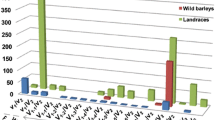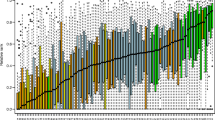Abstract
In barley, variation in the requirement for vernalization (an extended period of low temperature before flowering can occur) is determined by the VRN-H1, -H2 and -H3 loci. In European cultivated germplasm, most variation in vernalization requirement is accounted for by alleles at VRN-H1 and VRN-H2 only, but the range of allelic variation is largely unexplored. Here we characterise VRN-H1 and VRN-H2 haplotypes in 429 varieties representing a large portion of the acreage sown to barley in Western Europe over the last 60 years. Analysis of genotype, intron I sequencing data and growth habit tests identified three novel VRN-H1 alleles and determined the most frequent VRN-H1 intron I rearrangements. Combined analysis of VRN-H1 and VRN-H2 alleles resulted in the classification of seventeen VRN-H1/VRN-H2 multi-locus haplotypes, three of which account for 79% of varieties. The molecular markers employed here represent powerful diagnostic tools for prediction of growth habit and assessment of varietal purity. These markers will also allow development of germplasm to test the behaviour of individual alleles with the aim of understanding the relationship between allelic variation and adaptation to specific agri-environments.


Similar content being viewed by others
References
Chiapparino E, Donini P, Reeves J, Tuberosa R, O’Sullivan DM (2006) Distribution of β-amylase I haplotypes among European cultivated barleys. Mol Breed 18:341–354
Cockram J, Jones H, Leigh FJ, O’Sullivan D, Powell W, Laurie DA, Greenland AJ (2007) Control of flowering time in temperate cereals: genes, domestication and sustainable productivity. J Exp Bot 58:1231–1244
Danyluk J, Kane NA, Breton G, Limin AE, Fowler DB, Sarhan F (2003) TaVRT-1, a putative transcription factor associated with vegetative to reproductive transition in cereals. Plant Physiol 132:1849–1860
Dubcovsky J, Lijavetzky D, Appendino L, Tranquilli G (1998) Comparative RFLP mapping of Triticum monococcum genes controlling vernalization requirement. Theor Appl Genet 97:968–975
Dubcovsky J, Chen C, Yan L (2005) Molecular characterization of allelic variation at the VRN-H2 vernalization locus in barley. Mol Breed 15:395–407
Dubcovsky J, Loukoianov A, Fu D, Valarik M, Sanchez A, Yan L (2006) Effect of photoperiod on the regulation of wheat vernalization genes VRN1 and VRN2. Plant Mol Biol 60:469–480
Fischbeck G (2003) Diversification through breeding. In: von Bothmer R, van Hintum T, Khuepffer H, Sato K (eds) Diversity in barley (Hordeum vulgare). Elsevier, Amsterdam, pp 29–52
Fu D, Szűcs P, Yan L, Helguera M, Skinner JS, von Zitzewitz J, Hayes PM, Dubcovsky J (2005) Large deletions within the first intron in VRN-1 are associated with spring growth habit in barley and wheat. Mol Genet Genomics 273:54–65
Karsai I, Szűcs P, Mészáros K, Filichkina T, Hayes PM, Skinner JS, Láng L, Bedő Z (2005) The Vrn-H2 locus is a major determinant of flowering time in a facultative × winter growth habit barley (Hordeum vulgare L.) mapping population. Theor Appl Genet 110:1458–1466
Laurie DA, Pratchett N, Bezant JH, Snape JW (1995) RFLP mapping of five major genes and eight quantitative trait loci controlling flowering time in a winter × spring barley (Hordeum vulgare L.) cross. Genome 38:575–585
Laurie DA (1997) Comparative genetics of flowering time. Plant Mol Biol 35:167–177
Liu J, He Y, Amasino R, Chen X (2004) siRNAs targeting an intronic transposon in the regulation of natural flowering behavior in Arabidopsis. Genes Dev 18:2873–2878
Melchinger AE, Graner A, Singh M, Messmer M (1994) Relationships among European barley germplasm: I. genetic diversity among winter and spring cultivars revealed by RFLPs. Crop Sci 34:1191–1199
Schmitz J, Franzen R, Ngyuen TH, Garcia-Maroto F, Pozzi C, Salamini F, Rohde W (2000) Cloning, mapping and expression analysis of barley MADS-box genes. Plant Mol Biol 42:899–913
Szűcs P, Karsai I, von Zitzewitz J, Mészáros K, Cooper LLD, Gu YQ, Chen THH, Hayes PM, Skinner JS (2006) Positional relationships between photoperiod response QTL and photoreceptor and vernalization genes in barley. Theor Appl Genet 112:1277–1285
Szűcs P, Skinner JS, Karsai I, Cuesta-Marcos A, Haggard KG, Corey AE, Chen THH, Hayes PM (2007) Validation of the VRN-H2/VRN-H1 epistatic model in barley reveals that intron length variation in VRN-H1 may account for a continuum of vernalization sensitivity. Mol Genet Genomics 277:249–261
Takahashi R, Yasuda S (1971) Genetics of earliness and growth habit in barley. In: Nilan RA (ed) Barley genetics II (proceedings of the second international barley genetics symposium). Washington State University Press, Pullman, pp 388–408
Tottman DR, Makepeace RJ (1979) An explanation of the decimal code for the growth stages of cereals, with illustrations. Annals Appl Biol 93:221–234
Trevaskis B, Bagnall DJ, Ellis MH, Peacock J, Dennis EJ (2003) MADS box genes control vernalization-induced flowering in cereals. Proc Natl Acad Sci USA 100:13099–13104
Trevaskis B, Hemming MN, Peacock WJ, Dennis ES (2006) HvVRN2 responds to daylength, whereas HvVRN1 is regulated by vernalization and developmental status. Plant Physiol 140:1397–1405
Yan L, Loukoianov A, Tranquilli G, Helguera M, Fahima T, Dubcovsky J (2003) Positional cloning of the wheat vernalization gene VRN1. Proc Natl Acad Sci USA 100:6263–6268
Yan LL, Loukoianov A, Blechl A, Tranquilli G, Ramakrishna W, SanMiguel P, Bennetzen JL, Echenique V, Dubcovsky J (2004) The wheat VRN2 gene is a flowering repressor down-regulated by vernalization. Science 303:1640–1644
Yan L, von Zitzewitz J, Skinner JS, Hayes PM, Dubcovsky J (2005) Molecular characterization of the duplicated meristem identity genes HvAP1a and HvAP1b in barley. Genome 48:905–912
Yasuda S, Hayashi J, Moriya I (1993) Genetic constitution for spring growth habit and some other characters in barley cultivars in the Mediterranean coastal regions. Euphytica 70:77–83
Yan L, Fu D, Li C, Blechl A, Tranquilli G, Bopnafede M, Sanchez A, Valarik M, Yasuda S, Dubcovsky J (2006) The wheat and barley vernalization gene VRN3 is an orthologue of FT. Proc Natl Acad Sci USA 103:19581–19586
von Zitzewitz J, Szűcs P, Dubcovsky J, Yan L, Francia E, Pecchioni N, Casas A, Chen THH, Hayes P, Skinner J (2005) Molecular and structural characterization of barley vernalization genes. Plant Mol Biol 59:449–467
Acknowledgments
This work was supported in part by Defra project VS0137 and the GEDIFLUX project (contract No. QLK5-CT-2001-00934), supported by the European Commission. S.T. was funded by grant 208/D14003 from the UK Biotechnology and Biological Sciences Research Council, UK.
Author information
Authors and Affiliations
Corresponding author
Additional information
Communicated by J. Dubcovsky.
Electronic supplementary material
Below is the link to the electronic supplementary material.
Rights and permissions
About this article
Cite this article
Cockram, J., Chiapparino, E., Taylor, S.A. et al. Haplotype analysis of vernalization loci in European barley germplasm reveals novel VRN-H1 alleles and a predominant winter VRN-H1/VRN-H2 multi-locus haplotype. Theor Appl Genet 115, 993–1001 (2007). https://doi.org/10.1007/s00122-007-0626-x
Received:
Accepted:
Published:
Issue Date:
DOI: https://doi.org/10.1007/s00122-007-0626-x




